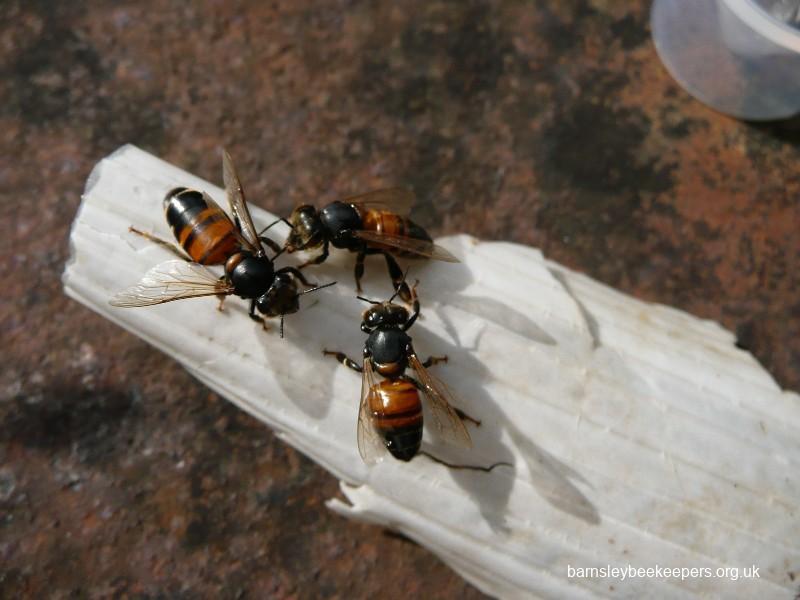Insights from Professor Giles Budge, Newcastle University
As the beekeeping community grows more aware of Chronic Bee Paralysis Virus (CBPV), this disease has become an increasing concern for both amateur and professional beekeepers across the UK. Thanks to the valuable research led by Professor Giles Budge and his team at Newcastle University, we now have a clearer understanding of how CBPV behaves, how to spot it, and what steps can be taken to manage its impact.
This post takes you through the latest science, practical advice, and fascinating insights from Professor Budge’s lecture, helping you stay informed and vigilant in protecting your colonies.
What is Chronic Bee Paralysis Virus?
Let’s start by clarifying terms:
- Chronic Bee Paralysis (CBP) is the disease.
- Chronic Bee Paralysis Virus (CBPV) is the virus causing it.
CBPV targets the adult bees, infecting their neural tissue and leading to visible symptoms, paralysis, and often, mass death. Crucially, unlike brood diseases, this virus focuses on adult bees, and symptoms can emerge suddenly, giving the impression of an overnight disaster in the apiary.
Recognising the Symptoms
Understanding the two types of symptoms is crucial for early detection:
Type 1 Symptoms (Early-stage)
- Trembling, shivering, or shaking bees.
- Displaced bees clustering on top bars or lugs, unresponsive to smoke.
- These bees often die within 5–7 days and are ejected from the hive.
Type 2 Symptoms (Later-stage)
- Bees appear darker, hairless, shiny, or greasy.
- Nibbled wings, often the result of nestmates trying to remove sick bees.
- Clusters of dead or paralyzed bees at the hive entrance or inside.

Importantly, even piles of seemingly dead bees may contain twitching, paralysed individuals — these bees are still alive but severely affected.
How Does CBPV Spread?
CBPV has multiple routes of transmission:
- Contact transmission: Bees rubbing against each other spread the virus mechanically.
- Faecal-oral route: Infected faeces transmit the virus to other bees.
- Direct injection (as in scientific experiments): When injected, the virus rapidly causes fatal infection — although Varroa is not thought to be a significant vector for CBPV.
- Dead bees: Infected corpses remain a potent source of infection for weeks or months.
- Other insects: Ants, flies, and even commercial bumblebees have been found carrying high levels of CBPV.
Curiously, unlike brood diseases, moving honey, pollen, or brood between colonies does not seem to transfer the infection reliably.
Risk Factors for Infection
Professor Budge’s research highlighted several risk factors:
- Bee imports: Colonies with imported queens had a 1.8x higher risk, although not because of infected attendant workers — rather, the receiving colonies already harboured the virus.
- Professional beekeeping: Larger-scale operations had a 1.5x higher risk, likely due to colony density.
- Colony congestion: High-density environments aid the spread, as demonstrated in laboratory studies.
Additionally, experiments showed:
- Young bees are especially vulnerable. Bees less than 24 hours old were highly susceptible to oral infection, while older bees displayed resistance.
- Pollen supply matters. Lack of pollen increased bees’ susceptibility to infection.
Does CBPV Just “Appear”?
Many beekeepers describe CBPV as seemingly arriving out of nowhere. But detailed monitoring shows:
- CBPV builds gradually, often undetected.
- Traps at hive entrances detected increased dead bees up to four weeks before visible symptoms appeared.
- Symptoms escalate as viral loads increase, with symptomatic colonies showing 230,000 times more virus particles than asymptomatic ones.
Control and Management Strategies
Currently, there is no “cure” for CBPV. However, informed management can make a difference:
Dead Bee Management
- Remove dead bees from the hive and surrounding area.
- Infected corpses remain a source of infection for months, even when decomposed.
Pollen Supply
- Ensure colonies have access to good-quality pollen.
- Supplement if natural sources are scarce, as this may boost resilience.
Hive Layout and Ventilation
- Avoid congestion by spacing frames appropriately.
- Provide wider entrances to help bees remove dead nestmates.
Experimental: Brood Separation
- Early trials of separating young bees and brood from older bees show some promise in disrupting the infection cycle.
What About Hive Sterilisation?
- Current evidence suggests that equipment does not need to be scorched or sterilised after an outbreak, unlike foulbrood protocols.
- Focus efforts on removing infected bees and improving colony conditions.
What We Still Don’t Know
While much progress has been made, CBPV research continues. Outstanding questions include:
- Why does CBPV emerge rapidly in some colonies but remain dormant in others?
- Are there environmental factors (e.g., forage availability, stress) that tip the balance?
- Can breeding for resistance play a role?
- How long exactly does environmental contamination last?
Ongoing studies at Newcastle and beyond aim to close these knowledge gaps.
Stay Informed
For further guidance:
- Download the BBKA information leaflet on CBPV via the BeeBase website.
- Stay connected with your local Bee Inspector for the latest updates and support.
By recognising the signs early, understanding how the disease spreads, and managing your colonies thoughtfully, you can help protect your bees from the devastating impact of Chronic Bee Paralysis Virus.
